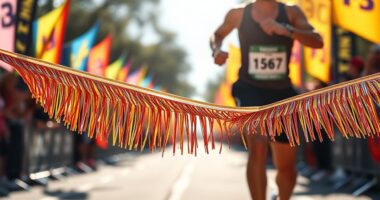Cross-country running traces back to ancient military drills and rural community events, where people practiced endurance and agility over rugged terrain. Soldiers used running to build stamina and navigation skills, while local communities held informal races during festivals to test speed and foster camaraderie. Over time, these practices grew into organized competitions with formal rules, preserving resilience and tradition. If you continue exploring, you’ll discover even more about how these historic roots shape the sport today.
Key Takeaways
- Cross-country running originated from trail and endurance races dating back thousands of years.
- Military training exercises over rugged terrain contributed to the development of endurance and navigation skills.
- Rural community festivals featured informal races, fostering camaraderie and cultural identity.
- Over time, these traditions evolved into organized competitions with formal rules and structure.
- Modern cross-country emphasizes rugged terrain, teamwork, and perseverance, reflecting its ancient and rural roots.

Cross-country running has roots that stretch back thousands of years, evolving from ancient practices of trail and endurance racing. During those early times, it wasn’t just about sport or recreation; it served practical and cultural purposes. You might find it fascinating that ancient military training often involved running over rugged terrain to build stamina, agility, and mental toughness. Soldiers would run long distances across varied landscapes, practicing endurance and navigation—skills that are still essential in cross-country today. These military exercises weren’t just about physical conditioning; they also fostered discipline and strategic thinking, qualities that modern cross-country runners develop during their training.
Ancient military drills over rugged terrain built stamina, discipline, and strategic skills vital to cross-country running today.
In rural communities, running held a different kind of significance, often intertwined with local festival traditions. Many rural festivals included running competitions that tested agility and speed, serving as communal events that brought people together. These races weren’t always formal or organized like today’s meets; instead, they emerged out of local customs and celebrations. For example, villagers might organize spontaneous races through fields and along country roads, creating a sense of camaraderie and local pride. These traditions helped preserve the cultural identity of rural areas and made running an accessible activity for all ages, not just athletes. Over time, these informal races contributed to the development of more organized cross-country competitions, blending sport with cultural expression.
As these early practices evolved, they began to adopt more formal rules and structures. Military training methods influenced the development of endurance running, emphasizing stamina, resilience, and strategic pacing. Meanwhile, rural festival traditions contributed a sense of community and storytelling to the sport, making it more than just physical exertion. Instead, running became a way for people to connect with their heritage, challenge themselves, and forge bonds within their communities. This blend of practical endurance training and cultural celebration set the foundation for modern cross-country running, which continues to honor its roots by emphasizing perseverance, community spirit, and a connection to history.
Today, you can see these origins reflected in the sport’s focus on rugged terrain, teamwork, and endurance. Cross-country isn’t just a race; it’s a continuation of ancient military exercises and rural traditions that have been passed down through generations. Whether you’re running through natural landscapes or competing in a community event, you’re participating in a tradition that has endured for thousands of years—one rooted in resilience, cultural pride, and the timeless human desire to push boundaries.
Frequently Asked Questions
When Did Cross-Country Running First Become an Organized Sport?
You’ll find that cross-country running became an organized sport in the late 19th century, around the 1860s and 1870s. As you train, you’ll learn race strategies that focus on pacing and terrain adaptation, which originated from early competitions. These training methods and strategies helped formalize the sport, making it popular worldwide. Today, you can refine your skills by studying its history and applying effective race techniques.
Which Countries Have the Oldest Traditions in Cross-Country Running?
Imagine you’re stepping into ancient athletic traditions, where countries like Greece and Scotland boast the oldest cross-country running histories. These nations hold cultural significance through legendary races and rugged terrains that shaped the sport. Their enduring passion for running, dating back centuries, influences modern practices. Though you might check your smartwatch, these traditions remind you of the deep roots and community spirit that still thrive in the sport today.
How Has Cross-Country Running Equipment Evolved Over Time?
You’ve seen how cross-country running equipment has evolved through innovative gear and material advancements. Modern shoes now feature lightweight, breathable fabrics with specialized soles for better grip and shock absorption, thanks to new technologies like gel inserts and foam cushioning. Apparel has shifted to moisture-wicking, quick-drying fabrics, reducing discomfort during long runs. These improvements help runners perform better, stay comfortable, and adapt to diverse terrains, making cross-country running more efficient and enjoyable.
What Are the Key Differences Between Cross-Country and Track Running?
You might think cross-country and track running are similar, but they differ substantially. Cross-country covers varied terrain, requiring you to adapt your race strategies to hills, mud, and open fields, making it more unpredictable. In contrast, track running takes place on a flat, consistent surface, allowing for precise pacing and speed. These differences influence your approach, making cross-country more about endurance and adaptability, while track emphasizes speed and technique.
Who Are Some Notable Pioneers in the History of Cross-Country Running?
You should know that early trail innovators like William Campbell or Alfred Shrubb helped shape cross-country running, pushing its boundaries. Pioneering athletic clubs, such as the New York Athletic Club and the Amateur Athletic Union, supported this growth by organizing competitions and promoting trail running. These trailblazers and clubs laid the foundation for modern cross-country, inspiring countless runners to embrace the sport’s rugged, adventurous spirit.
Conclusion
As you trace the gentle hills and winding paths of cross-country running, you realize it’s like a quiet dance with history itself. Every step whispers stories of ancient journeys and distant landscapes, blending tradition with your own rhythm. Embrace this timeless pursuit as a delicate brushstroke on the vast canvas of sport. With each stride, you’re softly weaving your own thread into a tapestry that stretches back through time, connecting you to something greater than yourself.









